Articles
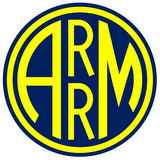 If you have an article you’d like to share dealing with Appalachian modeling or operation, please contact the site!
If you have an article you’d like to share dealing with Appalachian modeling or operation, please contact the site!
The following is a listing of ALL articles on Appalachian Railroad Modeling. Use the sub-menu from the “Articles” tab above for more tailored results.
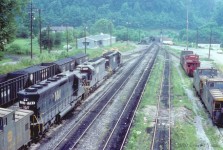
by Harry J. Dolan (Retired NS Trainmaster)
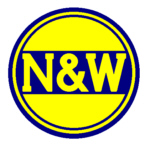 Big pusher consists (24 powered axles) were only used on loaded trains. “Time Freight” (General or Mixed Freight) pushers were limited to 14 powered axles. The former Southern pushed against cabooses, empty, and light loaded cars. As such, they limited pushers to 14 powered axles (example, two 4 axle & one 6 axle conventional units). High adhesion locomotive axles were counted as 1 1/3 conventional traction motors, hence, a C40-8 or an SD-60 with 6 actual axles would be counted as 8 axles. The N&W, on the other hand, pushed against 100 ton or heavier loads and limited their pusher consists to 24 powered axles (4 conventional SD’s … Read more →
Big pusher consists (24 powered axles) were only used on loaded trains. “Time Freight” (General or Mixed Freight) pushers were limited to 14 powered axles. The former Southern pushed against cabooses, empty, and light loaded cars. As such, they limited pushers to 14 powered axles (example, two 4 axle & one 6 axle conventional units). High adhesion locomotive axles were counted as 1 1/3 conventional traction motors, hence, a C40-8 or an SD-60 with 6 actual axles would be counted as 8 axles. The N&W, on the other hand, pushed against 100 ton or heavier loads and limited their pusher consists to 24 powered axles (4 conventional SD’s … Read more →

Realism means more than just nice models, it also means a nice model mix
by Dan Bourque
Most people realize that realism on a model railroad is not achieved by one or two nice models alone. Rather, realism is created as the sum of many factors. Good-looking scenery, a good trackplan and realistic-looking models are often the primary things our eyes notice right away. However, there are many more subtle characteristics which add to realism like a consistent era for all the models, the right amount of cars and locomotives on the layout and realistic operations when things are running. Another subtle way to add realism which many folks don’t think about is the MIX of your freight car … Read more →
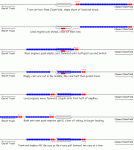
by Henry Statkowski
Photos and figures by the author
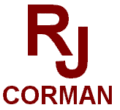 The R. J. Corman Railroad, Pennsylvania Line (Reporting Marks “RJCP”), operates over former New York Central and Pennsylvania trackage in West Central Pennsylvania (including a five-mile stretch over former Baltimore & Ohio (Buffalo, Rochester & Pittsburgh) and the joint NYC/PRR Cherry Tree & Dixonville Railroad). Operating westward from its connection with the ex-Conrail (now Norfolk Southern) Buffalo Line at Keating, PA, the RJCP continues westward to its hub at Clearfield, PA. From here, branches reach out in various directions to those coal-loading facilities still in operation. The coal-loading facility at Clymer, Pa. is one of them.
The R. J. Corman Railroad, Pennsylvania Line (Reporting Marks “RJCP”), operates over former New York Central and Pennsylvania trackage in West Central Pennsylvania (including a five-mile stretch over former Baltimore & Ohio (Buffalo, Rochester & Pittsburgh) and the joint NYC/PRR Cherry Tree & Dixonville Railroad). Operating westward from its connection with the ex-Conrail (now Norfolk Southern) Buffalo Line at Keating, PA, the RJCP continues westward to its hub at Clearfield, PA. From here, branches reach out in various directions to those coal-loading facilities still in operation. The coal-loading facility at Clymer, Pa. is one of them.
… Read more →

by Dan Bourque
In order to effectively model coal operations on your layout, you first have to understand how a mine run works on the prototype. In this article, I’ve drawn up a make-believe yard and branch line that our mine run (known as a “shifter” on some railroads like the N&W and Clinchfield) has to work. Like tipples, no two mine runs are exactly alike, and each has its own set of operating challenges. Our mine run will take us through several of these challenges and how a crew might handle them.
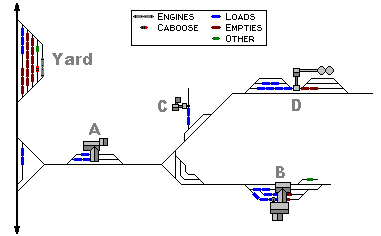 Our mine run starts in the yard with 2 … Read more →
Our mine run starts in the yard with 2 … Read more →

by Dave Beach
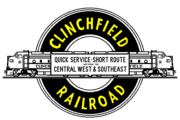 The diesel era helper operations on the South-end up to Altapass were really interesting. I think the pushers at least for coal trains often tied on before Erwin–maybe Johnson City or even Kingsport. I can remember seeing pushers cut into coal trains north of Erwin, but this was before the JC cutoff was built. I don’t know that they ever cut off at Poplar or were put on at Spruce Pine. I suppose that there could have been an occasional boost from the Spruce Pine switcher but doubt that it was a planned operation.
The diesel era helper operations on the South-end up to Altapass were really interesting. I think the pushers at least for coal trains often tied on before Erwin–maybe Johnson City or even Kingsport. I can remember seeing pushers cut into coal trains north of Erwin, but this was before the JC cutoff was built. I don’t know that they ever cut off at Poplar or were put on at Spruce Pine. I suppose that there could have been an occasional boost from the Spruce Pine switcher but doubt that it was a planned operation.
The cutoff at Altapass (or Ridge siding to be more exact) … Read more →
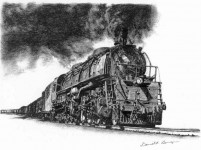
by Harry Sandlin
 The CRR used pushers and double-headed trains in the post war steam era as train tonnage increased. However, evidence of steam era pushers does not seem nearly as easy to find as in the diesel era. When Steam Ran the Clinchfield by James Goforth has several photos of double-headed trains, including merchandise trains. In Goforth’s book, the most dramatic evidence of pusher service is a photograph on page 100 of a southbound coal train with L-1 Mallet No.706 as pusher. The train had stopped to take on water at Boone, TN early in the afternoon of June 1, 1947. Class E-1 4-6-6-4 No. 656 shoved from the … Read more →
The CRR used pushers and double-headed trains in the post war steam era as train tonnage increased. However, evidence of steam era pushers does not seem nearly as easy to find as in the diesel era. When Steam Ran the Clinchfield by James Goforth has several photos of double-headed trains, including merchandise trains. In Goforth’s book, the most dramatic evidence of pusher service is a photograph on page 100 of a southbound coal train with L-1 Mallet No.706 as pusher. The train had stopped to take on water at Boone, TN early in the afternoon of June 1, 1947. Class E-1 4-6-6-4 No. 656 shoved from the … Read more →

by Scott Jessee
This article is a first-hand recollection of operations on the Fremont Branch as told by Scott Jessee, a Train Order Operator and Yardmaster at Dante, VA. To view a track plan for this area, click here. -Dan Bourque
 The 1st Moss Turn would go to work at 0700 hours with 9000hp on the Head end and 6000hp Pushing. It would usually get 10 to 20 Mtys out of Dante for the Lick Dock that was located at Moss #1 and would take more mtys if Moss #1 would need them. The 1st Moss Turn would then pick-up raw … Read more →
The 1st Moss Turn would go to work at 0700 hours with 9000hp on the Head end and 6000hp Pushing. It would usually get 10 to 20 Mtys out of Dante for the Lick Dock that was located at Moss #1 and would take more mtys if Moss #1 would need them. The 1st Moss Turn would then pick-up raw … Read more →

by David Thompson
To understand the history of the modern coal hopper, we have to start out at the dawn of the steel-car era. In the 1890s, the typical coal car was either a hopper-bottom gondola (flat floors over the trucks) or full-blown hopper cars with sloping floors and horizontal drop doors under the center sill. Sawtooth-style hoppers came into somewhat common use in that decade, with the 35-ton Pennsy GG of 1895 combining the sawtooth hoppers and a sloped floor. About this time, Carnegie Steel was taking some tentative steps toward building steel ore cars for the newly-extended PB≤ and, as things turned out, the Schoen Pressed Steel Car Company ended up as the pioneer of the … Read more →

by Dan Bourque
In ABCs of Coal Loaders, we learned about the different types of loaders used to load coal cars. Now let’s do a study of how the type of loader affects the appearance of the coal load.
When most of us think of coal loads, we think of the gently sloped and slightly humped pile of black stuff rising just barely over the top of the car. If you’re modeling a coal train far, far away from its loading point, this type of load is perfect. However, if you’re modeling the Appalachians, chances are you’re going to have a loader or two on your layout. For those of you in this category, you have to … Read more →
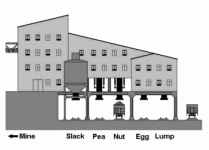
by Dan Bourque
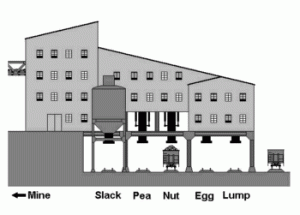 In ABCs of Coal, we learned a little about how coal is formed, now we’re going to look at coal where it meets the rails–at the tipple. I’m not going to go into depth about mining techniques, but here’s the basics. Coal is usually mined in two ways. The first is the traditional mine using a series of shafts and elevators to bring the excavated coal to the surface. The second is the strip mine where the ground on top of the coal is removed to expose the coal. Bulldozers, big buckets, and … Read more →
In ABCs of Coal, we learned a little about how coal is formed, now we’re going to look at coal where it meets the rails–at the tipple. I’m not going to go into depth about mining techniques, but here’s the basics. Coal is usually mined in two ways. The first is the traditional mine using a series of shafts and elevators to bring the excavated coal to the surface. The second is the strip mine where the ground on top of the coal is removed to expose the coal. Bulldozers, big buckets, and … Read more →
 If you have an article you’d like to share dealing with Appalachian modeling or operation, please contact the site!
If you have an article you’d like to share dealing with Appalachian modeling or operation, please contact the site! 




 Big pusher consists (24 powered axles) were only used on loaded trains. “Time Freight” (General or Mixed Freight) pushers were limited to 14 powered axles. The former Southern pushed against cabooses, empty, and light loaded cars. As such, they limited pushers to 14 powered axles (example, two 4 axle & one 6 axle conventional units). High adhesion locomotive axles were counted as 1 1/3 conventional traction motors, hence, a C40-8 or an SD-60 with 6 actual axles would be counted as 8 axles. The N&W, on the other hand, pushed against 100 ton or heavier loads and limited their pusher consists to 24 powered axles (4 conventional SD’s …
Big pusher consists (24 powered axles) were only used on loaded trains. “Time Freight” (General or Mixed Freight) pushers were limited to 14 powered axles. The former Southern pushed against cabooses, empty, and light loaded cars. As such, they limited pushers to 14 powered axles (example, two 4 axle & one 6 axle conventional units). High adhesion locomotive axles were counted as 1 1/3 conventional traction motors, hence, a C40-8 or an SD-60 with 6 actual axles would be counted as 8 axles. The N&W, on the other hand, pushed against 100 ton or heavier loads and limited their pusher consists to 24 powered axles (4 conventional SD’s … 

 The R. J. Corman Railroad, Pennsylvania Line (Reporting Marks “RJCP”), operates over former New York Central and Pennsylvania trackage in West Central Pennsylvania (including a five-mile stretch over former Baltimore & Ohio (Buffalo, Rochester & Pittsburgh) and the joint NYC/PRR Cherry Tree & Dixonville Railroad). Operating westward from its connection with the ex-Conrail (now Norfolk Southern) Buffalo Line at Keating, PA, the RJCP continues westward to its hub at Clearfield, PA. From here, branches reach out in various directions to those coal-loading facilities still in operation. The coal-loading facility at Clymer, Pa. is one of them.
The R. J. Corman Railroad, Pennsylvania Line (Reporting Marks “RJCP”), operates over former New York Central and Pennsylvania trackage in West Central Pennsylvania (including a five-mile stretch over former Baltimore & Ohio (Buffalo, Rochester & Pittsburgh) and the joint NYC/PRR Cherry Tree & Dixonville Railroad). Operating westward from its connection with the ex-Conrail (now Norfolk Southern) Buffalo Line at Keating, PA, the RJCP continues westward to its hub at Clearfield, PA. From here, branches reach out in various directions to those coal-loading facilities still in operation. The coal-loading facility at Clymer, Pa. is one of them.


 The diesel era helper operations on the South-end up to Altapass were really interesting. I think the pushers at least for coal trains often tied on before Erwin–maybe Johnson City or even Kingsport. I can remember seeing pushers cut into coal trains north of Erwin, but this was before the JC cutoff was built. I don’t know that they ever cut off at Poplar or were put on at Spruce Pine. I suppose that there could have been an occasional boost from the Spruce Pine switcher but doubt that it was a planned operation.
The diesel era helper operations on the South-end up to Altapass were really interesting. I think the pushers at least for coal trains often tied on before Erwin–maybe Johnson City or even Kingsport. I can remember seeing pushers cut into coal trains north of Erwin, but this was before the JC cutoff was built. I don’t know that they ever cut off at Poplar or were put on at Spruce Pine. I suppose that there could have been an occasional boost from the Spruce Pine switcher but doubt that it was a planned operation.




